| JULY 2023 |
|
2 in ďsaka (Sh˘chikuza), 5 shows in T˘ky˘ (Kabukiza, National Theatre, Shinbashi Enbuj˘, Asakusa K˘kaid˘), 1 in Ky˘to (Minamiza) and 1 tour (Eastern Provinces)!
|
| Sh˘chikuza (ďsaka) |  |
| Dates | 3 ~ 25 July 2023 Kansai Kabuki o Ai Suru Kai Shichigatsu ďkabuki The 31st Kansai Kabuki Lovers Society July Grand Kabuki |
| MatinÚe | |
| Evening |
Heike Nyogo no Shima (Shunkan) Yoshiwara Gitsune |
| Casting |
Living National Treasure Kataoka Nizaemon, Onoe Kikunosuke, Nakamura Ganjir˘, Nakamura Senjaku, Matsumoto K˘shir˘, Kataoka Takatar˘, Band˘ Yajűr˘, Nakamura Hayato, Nakamura Yonekichi, Nakamura Kikaku, ďtani Hirotar˘, Kataoka Sennosuke, Ichikawa Somegor˘, Nakamura Toranosuke |
| Comments |
31st edition of the Kansai Kabuki Lovers Society July Grand Kabuki in ďsaka. It celebrates the 100th anniversary of the opening of the Sh˘chikuza in ďsaka, which was built in 1923, modelled after the famous La Scala in Milan. After WW2, it became a movie theater. It was completely refurbished while preserving its appearance to reopen in 1999 as a theater, replacing the Nakaza for Kabuki performances.
|
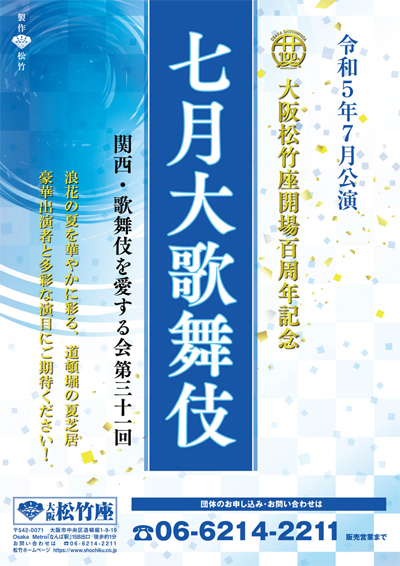 |
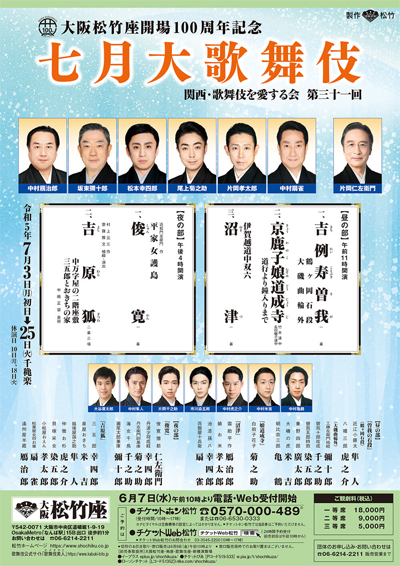 |
 |
| Kabukiza (T˘ky˘) |  |
| Dates | 3 ~ 28 July 2023 Shichigatsu ďkabuki July Grand Kabuki |
| MatinÚe | |
| Evening |
Shinrei Yaguchi no Watashi (Tonbŕ Sumika) Kami no Megumi Wag˘ no Torikumi Kamakura Hachimangű Shizuka no H˘rakumai |
| Casting |
Ichikawa Danjűr˘, Nakamura Jakuemon, Nakamura Kaishun, Ichikawa Ennosuke, Nakamura Kotar˘, Ichikawa Udanji, Nakamura Matagor˘, Ichikawa Chűsha, Ichikawa Monnosuke, Ichikawa Emisabur˘, Ichikawa Emiya, Ichikawa En'ya, Ichikawa Juen, Ichikawa Kudanji, Kawarasaki Gonjűr˘, Ichimura Manjir˘, Ichikawa Sai'nyű, Sawamura Yoshijir˘, Ichikawa Omez˘, Nakamura Kazutar˘, Nakamura Kotar˘, Nakamura Kash˘, Nakamura Tanenosuke, ďtani Hiromatsu, Ichikawa Shinnosuke, Ichimura Takematsu, Nakamura Fukunosuke, Nakamura Utanosuke, Nakamura Tamatar˘, Ichikawa Otora, Ichimura Hikaru, Asano Kazuyuki, Ichimura Kitsutar˘, Ichikawa Botan |
| Comments |
The usual July Grand Kabuki programs at the Kabukiza.
|
 |
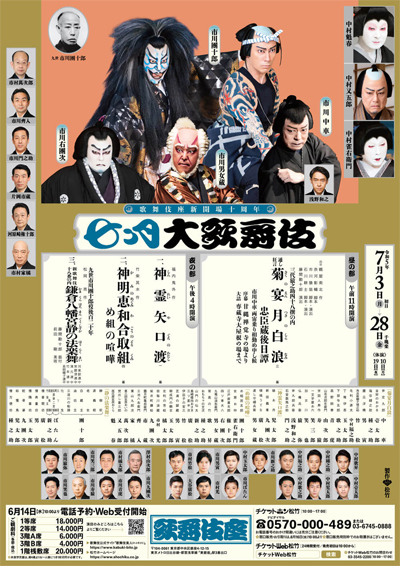 |
| National Theatre (T˘ky˘) |
| Dates | 3 ~ 24 July 2023 Shichigatsu Kabuki Kansh˘ Ky˘shitsu July Kabuki Appreciation Class |
| Program |
Kabuki no Mikata |
| Casting |
Nakamura Shikan, Nakamura Kinnosuke, Ichikawa Komaz˘, Band˘ Hikosabur˘, Nakamura Matsue, Nakamura Baika |
| Comments |
Educational program at the National Theatre called Kabuki Kansh˘ Ky˘shitu ("Kabuki Appreciation Class"). This is a very interesting formula for the beginners because there is lively presentation on stage (Kabuki no Mikata) of Kabuki or some aspects of the art like music, stage tricks or fighting scenes. It is followed by "Hikimado".
|
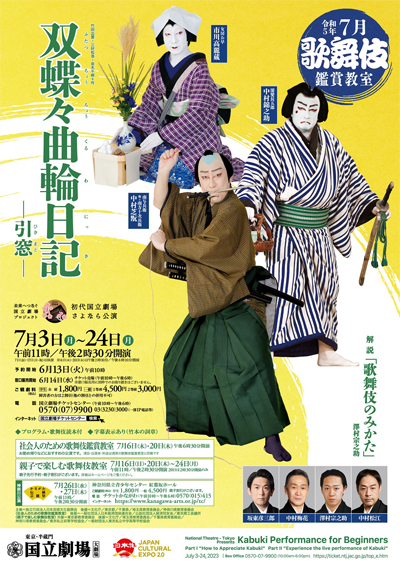 |
| Kabuki Tour in the Eastern Provinces | |
| Dates | 30 June ~ 31 July 2023 Sh˘chiku ďkabuki Higashi K˘su Sh˘chiku Grand Kabuki Eastern Course |
| Program | |
| Casting |
Onoe Sh˘roku, Band˘ Kamez˘, Nakamura Baishi, Nakamura Mantar˘, Band˘ Shingo, Onoe Sakon |
| Comments |
The July Grand Kabuki Tour in the Eastern Provinces.
|
 |
| Shinbashi Enbuj˘ (T˘ky˘) |  |
| Dates | 2 ~ 27 July 2023 Shinsaku Kabuki New Kabuki |
| Program | |
| Casting |
Living National Treasure Nakamura Baigyoku, Onoe Matsuya, Onoe Ukon, Nakamura Kangyoku, Nakamura Takanosuke, ďtani Keiz˘, Nakamura Kamenoj˘, Kamimura Kichitar˘, Kawai Yukinoj˘, ďtani Ryűsei, Sawamura Kuniya, Ichikawa Tsutanosuke |
| Comments |
A newly-created Kabuki drama based on a ... free-to-play collectible card browser video game named "T˘ken Ranbu" and developed by DMM.com LLC at the Shinbashi Enbuj˘.
|
 |
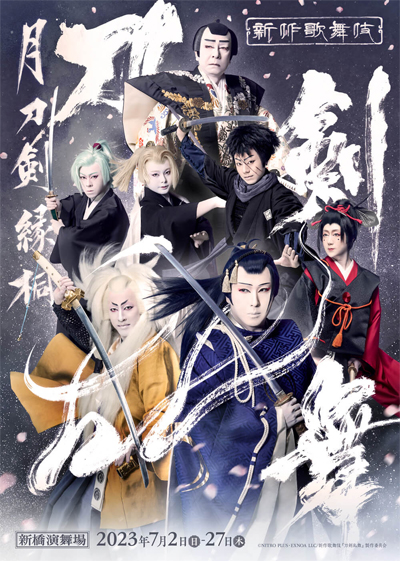 |
|
|||
| Dates | 30 June ~ 2 July 2023 Kamiyach˘ Sh˘kabuki Kamiyach˘ Little Kabuki |
||
| Program |
Goaisatsu Benten Musume Meo no Shiranami
|
||
| Casting |
Nakamura Hashinosuke, Nakamura Fukunosuke, Nakamura Utanosuke, Nakamura Baika |
||
| Comments |
1st edition of a gala for Nakamura Shikan's three sons. It is entitled Kamiyach˘ Sh˘kabuki ('Kamiyach˘ Little Kabuki'). Kamiyach˘ was the name of late Nakamura Shikan VII's neighboorhood in T˘ky˘ and it was used as an original way to appraise this great actor (kakegoe).
|
||
 |
|
|||
| Dates | 3 ~ 27 August 2023 Band˘ Tamasabur˘ Natsu no Hitotoki Band˘ Tamasabur˘ Summer Time |
||
| Program |
Taidan Kazutoyo to Chiyo Yukari no Tsuki |
||
| Casting |
Living National Treasure Band˘ Tamasabur˘ |
||
| Comments |
A special program starring Living National Treasure onnagata Band˘ Tamasabur˘ in Ky˘to at the Minamiza with the rakugo storyteller Shunpűtei Koasa.
|
||
 |
|
|
| Contact | Main | Top | Updates | Actors | Plays | Playwrights | Programs | Links | FAQ | Glossary | Chronology | Illustrations | Prints | Characters | Derivatives | Theaters | Coming soon | News |